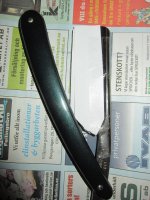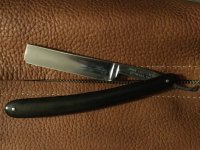I got into straight razors because I bought waterstones for my kitchen knives, found them surprisingly enjoyable, and wanted more things to sharpen.
So now I have several unremarkable razors from ebay that I've acquired to refine my honing skills. I disinfect with scrubbing bubbles and use a light mineral oil to protect the pivot. Some, like the first one (that Slash correctly estimated would become a favourite) colour that oil a bit red rather than black like most of them. So there's at least some rust in there. The bad kind.
Provided I continue to keep the pivot dry, oiled, and store the razor away from significant moisture (I don't keep it in the bathroom and I'm looking into a getting a sealed box with dessicant packs before the sometimes humid summer), will this significantly degrade if I take a year or three to get around to rescaling it? I'm not super-interested in scales. I've gotten a woodworker I know intrigued by straights and am hoping that he takes up the scale end of things but it might be a bit yet.
Alternatively, will evaporust be terrible for all/most scale materials? If I soak the pivot in it, rinse it off thoroughly, then dry with a hair dryer and maybe leave it in some rice for a week before re-applying a liberal amount of oil, well, that'd do it right? Except for the part where I don't get through that plan with my scales intact? Would bone or horn fare better than plastic? Worse?
So now I have several unremarkable razors from ebay that I've acquired to refine my honing skills. I disinfect with scrubbing bubbles and use a light mineral oil to protect the pivot. Some, like the first one (that Slash correctly estimated would become a favourite) colour that oil a bit red rather than black like most of them. So there's at least some rust in there. The bad kind.
Provided I continue to keep the pivot dry, oiled, and store the razor away from significant moisture (I don't keep it in the bathroom and I'm looking into a getting a sealed box with dessicant packs before the sometimes humid summer), will this significantly degrade if I take a year or three to get around to rescaling it? I'm not super-interested in scales. I've gotten a woodworker I know intrigued by straights and am hoping that he takes up the scale end of things but it might be a bit yet.
Alternatively, will evaporust be terrible for all/most scale materials? If I soak the pivot in it, rinse it off thoroughly, then dry with a hair dryer and maybe leave it in some rice for a week before re-applying a liberal amount of oil, well, that'd do it right? Except for the part where I don't get through that plan with my scales intact? Would bone or horn fare better than plastic? Worse?





